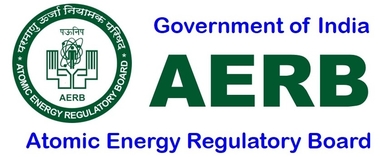AERB –Atomic Energy Regulatory Board
The Atomic Energy Regulatory Board was constituted on November 15, 1983 by the President of India by exercising the powers conferred by the Atomic Energy Act, 1962 to carry out certain regulatory and safety functions under the Act. The regulatory authority of AERB is derived from the rules and notifications promulgated under the Atomic Energy Act, 1962 and the Environment (Protection) Act, 1986.
|
AERB |
Atomic Energy Regulatory Board (AERB) A national authority designated by the Government of India having the legal authority for issuing regulatory consent for various activities related to the nuclear and radiation facility and to perform safety and regulatory functions, including their enforcement for the protection of site personnel, the public and the environment against undue radiation hazards.
|
|
Accelerator |
A device in which, charged particles are accelerated. Conventional X-ray tube is not considered as an accelerator.
|
|
Activity |
The quantity ‘A’ for an amount of radionuclide in a given energy state at a given time, defined as : where, ‘dN’ is the expectation value of the number of spontaneous nuclear transformation from the given energy state in a time interval ‘dt’. The SI unit of activity is the reciprocal of second (s-1), termed the Becquerel (Bq).
|
|
Applicant |
Any person who applies to the competent authority for consent to undertake any of the actions for which the consent is required.
|
|
Approval |
A type of consent issued by the regulatory body to a proposal. |
|
Authorisation
|
A type of regulatory consent issued by the regulatory body for all sources, practices and uses involving radioactive materials and radiation generating equipment (see also“Consent”).
|
|
Brachytherapy |
Branch of radiation therapy which relates to the uses of sealed sources for : (a) implants and intra-cavitory insertions, and (b) external mould/surface applications, in which the source to skin distance is not more that 5 cm. Some of the present day brachytherapy sources, e.g. 32 P coated stents and 192 Ir wires may not comply with all the regulatory requirements for sealed sources.
|
|
Commissioning |
The process during which structures, systems and components of a nuclear and radiation facility, on being constructed, are made functional and verified to be in accordance with design specifications and to have met the performance criteria.
|
|
Competent Authority
|
Any official or authority appointed, approved or recognised by the Government of India for the purpose of the Rules promulgated under the Atomic Energy Act, 1962.
|
|
Computed Tomography (CT) |
Reconstructive tomography in which image recording and processing are effected by a computing system.
|
|
Confinement System (Transport of Radioactive Materials) |
The assembly of fissile material and packaging components specified by the designer and accepted by the competent authority to preserve criticality.
|
|
Consent |
A written permission issued to the “consentee” by the regulatory body to perform specified activities related to nuclear and radiation facilities. The types of consents are ‘licence’, ‘authorisation’, ‘registration’ and ‘approval’, and will apply according to the category of the facility, the particular activity and radiation source involved
|
|
Consentee |
A person to whom consent is granted by the competent authority under the relevant Rules. |
|
Consignment |
Any package or packages, or load of radioactive material, presented by a consignor for transport.
|
|
Cyclotron |
A device in which charged particles (other than electrons) travel in a succession of semicircular orbits of increasing radii under the influence of a constant magnetic field and are accelerated by traversing a number of times in an electric field produced by a high frequency generator.
|
|
Criteria |
Principles or standards on which a decision or judgement can be based. They may be quantitative or qualitative. |
|
Decommissioning |
The process by which a nuclear or radiation facility is finally taken out of operation, in a manner that provides adequate protection to the health and safety of the workers, the public and the environment. |
|
Decontamination |
The removal or reduction of contamination by physical or chemical means. |
|
Defence-in-Depth |
Provision of multiple levels of protection for ensuring safety of workers, the public or the environment. |
|
Design |
The process and results of developing the concept, detailed plans, supporting calculations and specifications for a nuclear or radiation facility. |
|
Disposal (Radioactive Waste) |
The emplacement of waste in a repository without the intention of retrieval or the approved direct discharge of waste into the environment with subsequent dispersion. |
|
Documentation |
Recorded or pictorial information describing, defining, specifying, reporting or certifying activities, requirements, procedures or results. |
|
Dose |
A measure of the radiation received or absorbed by a target. The quantities terms absorbed dose, organ dose, equivalent dose, effective dose, committed equivalent dose, or committed effective dose are used, depending on the context. The modifying terms are used when they are not necessary for defining the quantity of interest. |
|
Dose Limit |
The value of the effective dose or the equivalent dose to individuals from controlled practice that shall not be exceeded. |
|
Emergency |
A situation which endangers or is likely to endanger safety of the site personnel, the nuclear/radiation facility or the public and the environment. |
|
Emergency Plan |
A set of procedures to be implemented in the event of an accident. |
|
Environment |
Everything outside the premises of a facility, including the air, terrain, surface and underground water, flora and fauna. |
|
Evacuation |
The temporary removal of persons from locations where dose rates or projected doses arising in an emergency situation are unacceptably high, or where the avertable dose exceeds the relevant intervention level. |
|
Exemption |
The deliberate omission of a practice, or specified sources within a practice, from regulatory control or from some aspects of regulatory control, by the regulatory body on the grounds that the exposures which the practice or sources cause or have the potential to cause are sufficiently low as to be of no regulatory concern. |
|
Fire Protection |
Measures directed towards prevention, detection and suppression of fire. |
|
Inspection |
Quality control actions, which by means of examination, observation or measurement, determine the conformance of materials, parts, components, systems, structures as well as processes and procedures with predetermined quality requirements. |
|
Inspector (Regulatory)
|
A person authorised by the regulatory body to carry out regulatory inspection. |
|
Licence |
A type of regulatory consent, granted by the regulatory body for all sources, practices and uses for nuclear facilities involving the nuclear fuel cycle and also certain categories of radiation facilities. It also means authority given by the regulatory body to a person to operate the above said facilities. |
|
Licenced Person |
A person who has been licenced to hold certain licensed position of a nuclear power plant after due compliance with authorised procedure of certification by the regulatory body. |
|
Limit |
The value of a parameter or attribute (which is variable) used in certain specific activities or circumstances that must not be exceeded.
|
|
Medical Exposure |
Exposure incurred by patients as part of their own medical or dental diagnosis or treatment; by persons, other than those occupationally exposed, knowingly while voluntarily helping in the support and comfort of patients and; by volunteers in a programme of biomedical research involving their exposure.
|
|
Normal Exposure
|
An exposure which is expected to be received under normal operating conditions of an installation or a source, including possible minor mishaps that can be kept under control. |
|
Normal Operation |
Operation of a plant or equipment within specified operational limits and conditions. In case of a nuclear power plant, this includes, start-up, power operation, shutting down, shutdown state, maintenance, testing and refuelling. |
|
Nuclear Facility |
All nuclear fuel cycle and associated installations encompassing the activities from the front end to the back end of nuclear fuel cycle processes and also the associated industrial facilities such as heavy water plants, beryllium extraction plants, zirconium plant, etc.. |
|
Nuclear Fuel Cycle |
All operations associated with the production of nuclear energy, including mining, milling, processing and enrichment of uranium or processing of thorium, manufacture of nuclear fuel, operation of nuclear reactors, reprocessing of irradiated nuclear fuel, decommissioning, and any activity for radioactive waste management and research or development activity related to any of the foregoing. |







